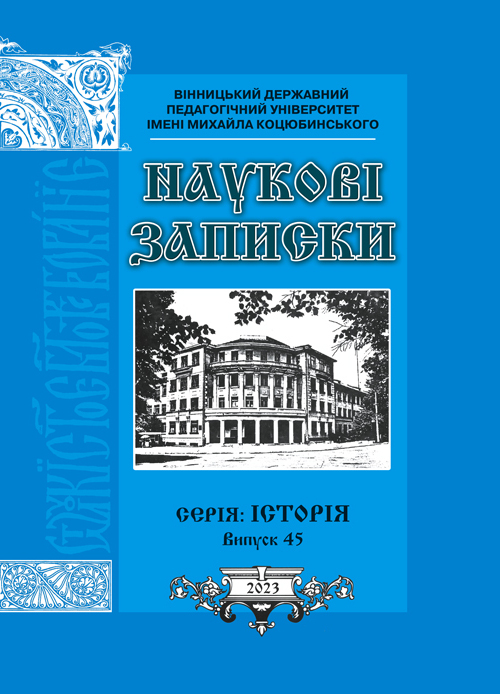Abstract
The purpose of the article is to cover the policy of Romanian occupation authorities to involve in the cooperation of the Vinnitsia region rural population during the World War II. The formation of relations of the Romanian occupation administration with the local population is shown and the forms of involvement of residents of the region in cooperation are revealed. The methodological basis of the research is a combination of general scientific methods, such as methods of analysis and synthesis, and special-historical methods, in particular historical-typological and historical-systemic methods with the principles of historicism, systematicity and comprehensiveness. The scientific novelty of the article arose that for the first time in Ukrainian historiography an attempt was made to characterize the policy of Romanian occupation authorities to involve in the cooperation of the Vinnychina rural population during the Second World War. The reasons that prompted the local population to take such a step are analyzed and the ways in which the Romanian occupation authorities implemented their policy in the occupied territory are outlined. Conclusions. The fulfillment of the main task of the Romanian occupation administration in Transnistria, in particular Vinnychina, assigned to it by Nazi Germany, the economic exploitation of the region, required the involvement of the local population in this process. It is fair to admit that a certain part of the Ukrainian peasantry cooperated at the initial stage of the Romanian occupation, hoping to improve their lives under the new government and avoid the repressions that took place in the region during Soviet times. Under these circumstances, not all residents of the occupied territories should be defined as conscious collaborators. In implementing the policy of engaging Ukrainian peasants in the Vinnychina region in cooperation, the Romanian occupation authorities relied on propaganda in their actions, using research on the implementation of twenty years of Bolshevik policy in Ukrainian lands, the population's hopes for the revival of Ukrainian life and the formation of a Ukrainian state, and people's desire to survive in the difficult conditions of war. In the occupied areas, the Romanian administration used non-violent (emphasizing the repression of the Bolshevik authorities, actively using propaganda and bribery of the population) and violent (using coercion) methods against the population of Vinnychina.
References
Боган, С. (2012). Колабораціоністські органи правопорядку на Півдні України у 1941-1944 рр. Наукові праці Чорноморського державного університету імені Петра Могили. Сер. : Історія. Т. 180. Вип. 168. С. 35-40.
Воловина, О., Плохій, С., Левчук, Т., Рудницький, О., Ковбасюк, А. & Шевчук, П. (2017). Реґіональні відмінності втрат від голоду 1932–1934 рр. в Україні. Український історичний журнал, 2. С. 76-116.
Гальчак, С. (2018). Поділля в роки Другої світової війни (1939-1945): монографія. Вінниця : Меркьюрі-Поділля, 656 с.
ДАВіО – Державний архів Вінницької області.
Косик, В. (1993). Україна і Німеччина у Другій світовій війні. Париж; Нью-Йорк; Львів, 659 с.
Кучер, В., Потильчак, О. (2011). Україна 1941–1944: трагедія народу за фасадом Священної війни. К.: Вид-во НПУ ім. М.П. Драгоманова. 357 с.
Лисенко, О. (ред.). (2010). Україна у Другій світовій війні: погляд з ХХІ ст. Історичні нариси: у 2-х т. Т. 1. Київ : Наукова думка, 735 с.
Подкур, Р. (2012). «Великий терор» на Вінниччині (1937 - 1938 рр.): діяльність територіального апарату органів державної безпеки, стереотипи світогляду чекістів. Злочини тоталітарних режимів в Україні: науковий та освітній погляд: Матеріали міжнародної наукової конференції (м. Вінниця, 21-22 листопада 2009 р.). К. : НІОД. С. 54-76
Потильчак, О. (1997). Економічний колабораціонізм в Україні в роки нацистської окупації (1941–1944): причини і прояви. К.: УДПУ ім. М.П. Драгоманова. 29 с.
Шайкан, В. (2005). Колабораціонізм на території рейхскомісаріату «Україна» і військової зони в роки Другої світової війни. Кривий Ріг: Мінерал. 466 с.

This work is licensed under a Creative Commons Attribution 4.0 International License.
Copyright (c) 2023 Людмила Бабій





